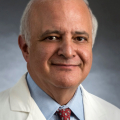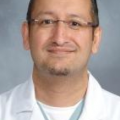In observance of Brain Injury Awareness Month, the American Neurological Association (ANA) reached out to three of its members working in the discipline of traumatic brain injury to inquire about the standard of treatment, myths surrounding the condition, and research in progress. Their responses are below.
Please also see a patient perspective of of daily life in "The Art of Living With TBI."
The Participants:
 |
Ramon Diaz-Arrastia, MD, PhD Professor of Neurology, University of Pennslyvania |
 |
David I. Kaufman, D.O. Professor and Chair, Department of Neurology & Ophthalmology Associate Dean of Clinical Affairs-COM, Michigan State University |
 |
Halinder Singh Mangat, MD Adjunt Clinical Assistant Professor of Neurology Weill Cornell Medicine |
Q. What does the public need to understand about traumatic brain injury (TBI) that it often doesn’t?
RDA: TBI is one of those very common conditions that there’s a lot of confusion and misperceptions about. One misperception is that for people with a severe brain injury to the point of coma -- often due to motor vehicle accidents or falls from tall heights -- that the outcome is always terrible. Even many neurosurgeons have that misconception.The patient often looks terrible in the ER and ICU in the first few days, and the physician will often counsel the family in the first day or two to withdraw care. In reality, because it’s often a disease of young people, who have strong potential for synaptic plasticity, recovery is often very good with appropriate care and attention to rehabilitation.
HSM: Traumatic brain injury is very common and the rates of TBI-related ED visits, hospitalizations and deaths are increasing in the US. The age group most affected is 0-4 year olds followed by 15-24 year olds. Falls are the most common cause across all ages especially in 0-4 and over 65 year olds, followed by physical impact with an object (being struck by an object or striking an object). While mild TBI (concussion) results in cognitive sequelae, severe TBI can leave one neurologically devastated or even cause death.
DIK: “Mild” Traumatic Brain Injury (mTBI) is many times a sports related event. Only 9% of people with an mTBI are knocked unconscious. The vast majority have other symptoms, however. Understanding the “SCAT V” evaluation is important for any parent of an individual playing a contact or collision sport. This SCAT V evaluation tool is easily found on the internet and can assist in making the diagnosis of mTBI. It is important to make the diagnosis of mTBI, as a second event soon after the first can delay recovery or cause a serious and acutely progressive neurologic event called “second impact syndrome.” Repetitive mTBI or even “sub concussive” blows to the head, repeatedly over many years, can lead to a chronic and progressive neuro-degenerative disease called chronic traumatic encephalopathy (CTE).
“Early diagnoses with eye tracking and blood biomarker tests are evolving rapidly and diagnosis of mild TBI is improving dramatically.” |
|
Halinder Singh Mangat, MD |
Q. How are treatment options for TBI different today from 10 years ago?
RDA: I’m disappointed to say they are not really that different. In the 70s, 80s, and 90s, there was improvement in critical care management of the injuries, and the mortality rate dropped by approximately half, from 40 percent to 20 percent. But over the last 10-20 years, we’ve been in a plateau. There’s a lot of research in the field, but a lot of it has been disappointing. The recognition, especially in the mild end of the spectrum, that these injuries require treatment has led to more widespread use of physical therapy and occupational therapy, and that probably is helpful, but it’s not better than what we were doing 10 years ago. And it doesn’t work for everybody.
DIK: There have been major advances made in prevention of mTBI. This has included rule changes at the collegiate and professional level especially in contact sports like soccer and basketball and collision sports like football and ice hockey. This appears to have reduced the number of events, although rigorous statistics from previous years have not been documented as carefully as they are now. Diagnosis of mTBI has improved based on dissemination of literature on this subject, education of the athletes, family members and coaches. SCAT V evaluations also have allowed more people to be diagnosed. This prevents second impact syndrome that can delay recovery dramatically if the first mTBI is not diagnosed.
Treatment options remain elusive although a number of research studies are looking at the neuro-immunology of this disorder. These have promise to perhaps reduce the length and size of disability. Treating the visceral issues following mTBI (headache, nausea, double vision, sleep disturbance, etc.) has emerged as an important way to help patients cope with mTBI until the central nervous system stabilizes after these events. The development and use of the strategy of gradual progression toward return to play and return to learn (rather than keeping athletes in a dark room) has also improved the speed of recovery in mTBI.
HSM: There are no new therapies in the last decade for mild and moderate TBI. Intensive care management has improved significantly and severe TBI deaths have decreased across the US. For survivors of severe TBI, rehabilitation remains a key component of recovery management.
“In some ways, this is the golden era of research in traumatic brain injury.” |
|
Ramon Diaz-Arrastia, MD, PhD |
Q. What promising research is poised to change the standard of treatment for TBI?
DIK: Diagnosis with blood assays will help in questionable cases of mTBI, allowing future therapeutic strategies to be employed earlier. Advanced MRI scans like functional MRI (fMRI) and Diffusion Tensor Imaging may also help with determining prognosis early and which treatment strategy, if employed early, could improve the natural history in a positive way. The NCAA [National Collegiate Athletic Association] and Department of Defense have also launched a very ambitious registry of student athletes and warriors with mTBI to better understand the prevalence, prognosis and natural history of mTBI.
HSM: Early diagnoses with eye tracking and blood biomarker tests are evolving rapidly and diagnosis of mild TBI is improving dramatically. This leaves the field poised for developing therapies that can be instituted quickly. In severe TBI, use of a medication that promotes clotting is being trialed to demonstrate if it decreases brain hemorrhages following severe trauma. Preliminary results are promising.
RDA: In some ways, this is the golden era of research in traumatic brain injury. The main reason is that about 10 years ago, the Department of Defense came to the realization that brain injuries were a major problem for military service members, where injuries during training and as a consequence of living in dangerous environments, as well as in combat, are very common. The federal government has more than tripled its investment in research, mainly through investments from the Department of Defense, but investments by the NIH [National Institutes of Health] and the VA [U.S. Department of Veterans Affairs] in TBI science have also increased.
There’s a lot of excitement in research, as advances in basic science have identified biomarkers of injury, including imaging and molecular biomarkers to better characterize and identify the natural history of the injury. The hope is that these advances will translate into effective therapies. These investments continue. Both novel compounds and repurposed compounds are being researched. Many seem to work in animal models and are being translated into humans. None are around the corner, but I’m hopeful that by the time I retire…
Q. What work is your lab undertaking to move brain injury knowledge or treatment forward?
RDA: We’re doing a number of different things including trying to understand cerebrovascular injury after TBI -- how the mechanical impact results in injury to the blood vessels, particularly the microvasculature, and developing tools to measure the integrity of the neurovascular unit, using advanced MRI. We’re studying cerebrovascular function and the integrity of the blood-brain barrier to develop therapies to improve microvascular function. We published a paper last year in ACTN [Annals of Clinical & Translational Neurology ] showing that [Viagra] may have some benefit to improve cerebrovascular reactivity after traumatic brain injury.
HSM: Our goal has been to try to develop imaging markers that can show when the brain develops difficulty in harnessing energy for normal functioning after a brain injury. This can help create a target for therapies and monitor their effect to help restore the brain energy utilization to normal. This can be performed easily in a routine MRI scanner. We have also been working on improving treatment of TBI in low and middle-income countries by capacity building and research.
DIK: We have looked at collegiate football players following mTBI using functional MRI (fMRI) to determine changes related to this modality and comparing them to neurologic examination and computer assisted neuro-psychology testing. We noticed that at the onset of the mTBI there is hyper connectivity demonstrated by fMRI while the clinical testing was abnormal. All clinical testing converted to normal by day 7, but the fMRI showed hypo connectivity at day 7. This hypo connectivity improved but did not reach normal even by day 30 in some cases. This implies an mTBI alters brain physiology well past 7 days despite the neurologic exam and neuro-psychology testing being normal. This was published in the Journal of Neuro-Trauma.
“The ANA inspired us to do research through highlighting this disease process as a clear public health issue of significant size.” |
|
David I. Kaufman, D.O. |
Q. How has the ANA supported your career or work in this area?
DIK: The ANA inspired us to do research through highlighting this disease process as a clear public health issue of significant size.
HSM: The ANA Translational and Clinical Research Course for Clinician-Scientists is a fantastic course to attend. It included talks from leading NIH speakers that were very educational and inspiring. I have subsequently presented research findings at the ANA Annual Meeting and received very useful scientific feedback. It was a good opportunity to meet with senior leading investigators in the ANA.
RDA: Historically, neurologists were not at the forefront of TBI research. Neurology as a discipline largely ignored TBI, which is really a travesty. At least in North America, TBI was the purview of neurosurgeons because a small subset of TBIs require surgery, and after that, it was taken care of by specialists in physical medicine and rehabilitation. The paucity of neurologists interested in this condition has been a great detriment to TBI science. I think that era is over. The ANA had a plenary session last year on TBI and a special interest group that was very popular. Among our residents and fellows, many young neurologists are interested in focusing on TBI for their career.
